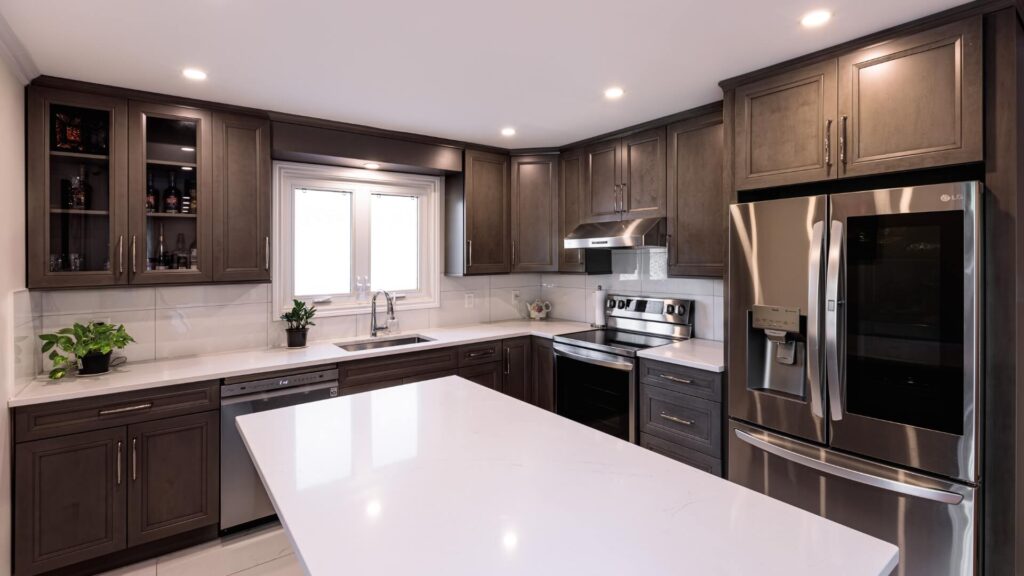A kitchen renovation is a significant investment in both comfort and home value. Choosing the best kitchen cabinet materials influences durability, maintenance, aesthetics, and suitability to Montreal’s seasonal extremes. With considerations like wood vs. MDF, cabinet longevity, eco-friendly materials, and custom vs. prefabricated cabinetry, this guide arms homeowners with insights for smart decisions that respect both style and climate.
Why Your Choice of Cabinet Material Matters
- Durability: Cabinets endure daily wear, from opening doors to moisture in kitchens.
- Maintenance & Style: Materials range from elegant hardwood to sleek, painted-engineered wood, each with distinct upkeep needs and aesthetics.
- Climate Considerations: Montreal winters plunge below –20 °C, and summers can soar above 30 °C. Cabinets must resist humidity and thermal variations without warping or cracking.
Choosing the right material helps ensure your cabinetry remains functional and beautiful through temperature extremes and daily use.
Solid Wood Cabinets: The Timeless Classic
Pros
- Longevity & Repairability: Solid hardwoods such as maple, oak, or cherry can be sanded and refinished many times, offering decades of life.
- Unique Aesthetics: Visible wood grain adds warmth and authenticity.
- Strength: Ideal for doors and frames that experience daily wear.
Cons
- Cost: Typically the most expensive option, ranging $100–$300+ per linear foot
- Moisture-Sensitive: Without careful sealing, humidity can warp wood.
Best Wood Types for Montreal
- Maple: Light tone, fine grain, great for painted finishes.
- Oak (White or Red): Durable, with strong grain—classic for traditional kitchens.
- Cherry: Rich, elegant, and darkens naturally—great for formal designs.
MDF Cabinets: A Budget-Friendly Alternative
Pros
- Smooth Finish for Painting: Ideal for modern or shaker-style cabinetry.
- Cost-Effective: Significantly cheaper than hardwood .
- Stable Construction: Does not warp or shrink like solid wood.
Cons
- Moisture Risks: Vulnerable to swelling if water penetrates seams.
- Less Durable Under Stress: Edges are brittle and can chip.
- Shorter Lifespan than Wood.
Ideal Uses
- Painted cabinetry
- Sleek, modern kitchen designs or secondary spaces (e.g., laundry rooms).
Plywood Cabinets: The Middle Ground
Pros
- Strength & Stability: Less prone to warping; holds screws reliably.
- Moisture Resistance: Better than MDF for humid areas.
Cons
- Higher Cost than MDF: Though more affordable than solid wood.
- Potential Delamination: Lower-grade plywood can fail; use marine-grade for durability
The most balanced choice for cabinets where structural strength and reasonable cost are priorities.
Eco-Friendly and Sustainable Cabinet Options
- Bamboo: Fast-growing, renewable, and durable alternative to hardwood.
- Reclaimed Wood: Gives character and diverts waste wood.
- FSC-Certified Plywood & MDF: Ensures sustainable sourcing.
- Natural Fibre Board: Formaldehyde-free panels made from wood fibers.
Use low-VOC paints and finishes to ensure healthy indoor air—important during renovations in closed winter homes .
Custom Cabinetry vs Prefabricated: Which is Right for You?
Custom Cabinetry
- Perfect Fit & Design Freedom: Ideal for unique layouts and features.
- Material Choice & Quality: Select exactly what works for your style and climate.
- Higher Cost & Longer Lead Times.
Prefabricated Cabinets
- Affordable & Quick: Ideal when budget or time is limited.
- Limited Styles and Materials: Less customization; may not suit every Montreal home.
Factors to Consider When Choosing Your Cabinet Material
- Cooking & Lifestyle: Frequent cooking demands durable, moisture-resistant material.
- Maintenance: Wood can be polished; MDF is easy to wipe. Veneers require care.
- Budget & Value: Solid wood has longevity; plywood gives strength at moderate cost; MDF prioritizes affordability.
- Design Style: Contemporary styles often use painted MDF or thermofoil; classic interiors suit natural contrasts of wood and veneer.
Why Work with a Local Montreal Cabinet Maker
- Climate Expertise: Local makers understand humidity, temperature swings, and can adjust designs accordingly.
- Access to Materials: Regional availability of veneered hardwood or FSC-certified boards reduces costs and carbon footprint.
- Tailored Solutions: Local specialists like Mont‑River can manage on-site adjustments, custom measurements, and seamless installation aligned with Montreal home layouts.
FAQs
1. Which kitchen cabinet material lasts the longest?
Solid hardwood—like maple or oak—can last decades with proper care. Marine-grade plywood follows closely in performance.
2. Are MDF cabinets good for high-humidity kitchens like Montreal’s?
Only if well sealed and finished. For moisture-prone areas, plywood or hardwood is more reliable.
3. Can eco-friendly cabinets be customized for small kitchens?
Absolutely. Sustainable materials like bamboo or reclaimed wood are perfect for custom builds—even in compact spaces.4. What’s the cost difference between solid wood and MDF cabinets?
Solid wood typically costs $100–$300+ per linear foot. MDF runs $50–$75, while plywood sits between the two .

